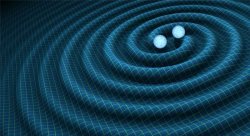Professor Assists in Proving Einstein’s Theory Again
Posted in: Uncategorized

On June 15, the Laser Interferometer Gravitational-wave Observatory (LIGO) collaboration (which includes Montclair State University Assistant Professor of Physics Marc Favata) once again made scientific history when they announced the second detection of gravitational waves by the twin LIGO detectors on December 26, 2015.
Favata and recent Montclair State University graduate Blake Moore – listed as co-authors on the group’s first discovery paper in January, 2016 – will once again appear as co-authors on the second paper.
The gravitational waves were detected by both LIGO detectors, located in Livingston, Louisiana, and Hanford, Washington. The waves from the second event were produced by the inspiral of two black holes – 14 and 8 times the mass of the sun, respectively – which merged to produce a single, spinning black hole that is 21 times the mass of the sun. This discovery further confirms a major prediction of Albert Einstein’s 1915 general theory of relativity and continues to allow exploration of an unprecedented new window into the cosmos.
“The second direct detection of gravitational waves is an important confirmation of LIGO’s ability to deliver on the science it has promised,” said Favata. “It is from a black hole pair with smaller total mass than the first detection. For this system, LIGO ‘hears’ a longer duration signal that reaches to higher frequencies than the first.
“This is exciting because LIGO is starting to probe the population of stellar-mass black holes.”
The gravitational waves were detected at 10:38pm Eastern Time on December 25, 2015 (3:38am Coordinated Universal Time). The LIGO detectors are funded by the National Science Foundation (NSF), and were conceived, built, and are operated by Caltech and MIT. The discovery, accepted for publication in the journal Physical Review Letters, was made by the LIGO Scientific Collaboration (which includes the GEO Collaboration and the Australian Consortium for Interferometric Gravitational Astronomy) and the Virgo Collaboration using data from the two LIGO detectors.
In addition to technical studies on gravitational-wave emission, the Montclair State University LIGO group – of which both Favata and Moore are members – engages in several education and public outreach activities on behalf of the LIGO collaboration. The group has been involved in the preparation of multimedia materials related to the recent discoveries, including the development of a website, soundsofspacetime.org, that lets visitors explore the analogy between gravitational waves and sound waves and includes pages devoted to the recent detections.
“LIGO is breaking into its role as a new kind of astronomical observatory – a ‘microphone’ that hears distant waves of gravity emitted by dark parts of the universe. It’s very gratifying that Montclair State’s physics program and students are able to participate in this cutting-edge science.”
Click here to view a YouTube video of the two black holes colliding
